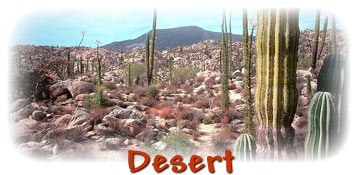| Cold Deserts of the World
The
main form of precipitation in a cold desert is snow or fog.
|
Cold Deserts of the World
|
Name
Location |
Size |
Physical
Features |
Some Plants &
Animals |
Special Facts |
Atacama
Coasts of Peru and Chile |
54,000 mi2
140,000 km2 |
Covered by sand dunes and pebbles. One of
the driest areas on earth. |
bunchgrass, cardon cactus, tamaruga trees
lizards, llama, Peruvian fox, nesting area for many seabirds |
Only a few thousand people (mostly farmers)
live in the inland desert areas.
Large deposits of sodium nitrate are found in the desert.
Sodium nitrate is used to make gunpowder. |
Gobi
Northern China and Southern Mongolia |
450,000 mi2
1,200,000 km2 |
Covered by sandy soil and areas of small stones
called "gobi." |
camel's thorn, grasses
bactrian bamel, gazelle, gerbil, jerboa, lizards, onager,
wolf |
Crossed by Genghis Khan in the early 13th
century. Many nomads now settling on government-run farms. |
Great Basin
Western United States (Idaho, Nevada, Oregon, and
Utah) |
158,000 mi2
411,000 km2 |
Covered by sand, gravel, and clay.
Many moutains ranges, basins, and large expanses of salt
flats. |
greasewood, sagebrush, shadscale
bighorn sheep, jackrabbit, pocket mouse, poor-will, pronghorn
antelope, sage thrasher, side-blotched lizard |
Great Salt Lake located here. |
Iranian
Iran, Afghanistan, and Pakistan |
150,000 mi2
390,000 km2 |
Covered by coarse gray soil, stony pavement,
and salt flats. |
grasses, pistachio trees, shrubs
monitor lizard, onager, oryx, scorpion |
World's largest salt flat located here. |
Namib
Coasts of Southwestern Africa |
52,000 mi2
135,000 km2 |
Covered by sand dunes along the coast and
gravel farther inland. |
aloe, bunchgrass, lichens, welwitschia
darkling beetle, fringe-toed lizard, golden mole, jackal,
sidewinder, viper, web-footed gecko |
Coast of the Namib Desert is world's greatest
source of gemstones. |
Takla Makan
Western China |
600,000 mi2
1,600,000km2 |
Covered by sand dunes and rocky soil. |
grasses, shrubs
bactrian camel, jerboa, long-eared hedgehog, gazelle |
The word "Takla Makan" means "place from which
there is no return."
Crossed by Marco Polo in the 13th Century. |
Turkestan
Parts of the Middle East and Southwestern Russia |
215,000 mi2
559,000 km2 |
Covered mostly by extensive stretches of sand
dunes. |
alhagi shrub, saxaul tree, sedges, thick ground
cover
desert tortoise, gazelle, gerbil, saiga antelope |
Crossed by caravans following silk route from
China in Europe in ancient times.
The great city of Samarkand, once a cultural and religious
center of central Asia, was located here. |
| Disclaimer |
Copyright © 2002 Missouri
Botanical Garden
|
 |
|
